Art Applewhite Rockets Ultra Delta Flying Saucer
Art Applewhite Rockets - Ultra Delta Flying Saucer {Kit}
Contributed by Bob Cox
| Construction Rating: | starstarstarstarstar |
| Flight Rating: | starstarstarstarstar |
| Overall Rating: | starstarstarstarstar |
| Manufacturer: | Art Applewhite Rockets  |
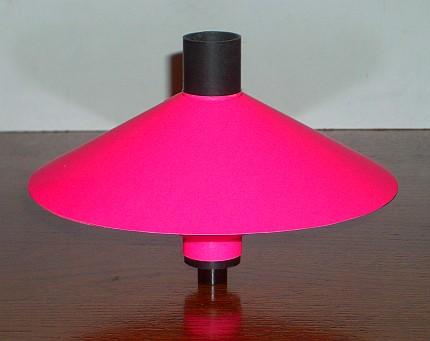 Overview
Overview
A cardstock flying saucer that can be built to fly on 18mm or 24mm engines.
Kit Specifications
- Diameter - 6 inches (15cm)
- Height - 2.75 inches (7cm)
- Weight - 0.5 oz (12gm)
Background:
Art Applewhite specializes in finless rockets that can be built from cardstock
and foamboard. He sells a kit called the Delta Flying Saucer that is built from
cardstock with a foam-board disk in the center for structural rigidity. The new
Ultra Delta uses a nifty cardstock folding technique to eliminate the foam
disk. This reduces the weight, increases the performance, and eliminates the
hardest step in the Delta construction, which was cutting the foam disk at a
precise angle.
Since I have experience with his other kits, Art invited me to be a beta
tester for the Ultra Delta. He sent me a six-pack of kits in a rainbow of
fluorescent colors. All of Art's kits are shipped in USPS Priority Mail boxes
with air-filled plastic pouches for protection. I have never received a damaged
part on any of his kits.
Parts List
- Two 8.5x11-inch sheets of printed cardstock
- Instructions
The instruction manual is printed on three 8.5x11-inch pages. The directions are very detailed and photo illustrations are plentiful.
CONSTRUCTION
Before construction begins, the builder must decide which configuration to build. The printed cardstock contains markings for either 18mm or 24mm engines. The 24mm version can be built with a motor block for C11 or D12 engines, or the block can be omitted for use with longer E9 and F21 motors.
I built all three variants. First I built a yellow 18mm version. Based on my
feedback from that build session, Art made some minor tweaks to the
instructions and to the printed pattern. I used those revised directions to
build a green 24mm short version and a hot pink 24mm long version.
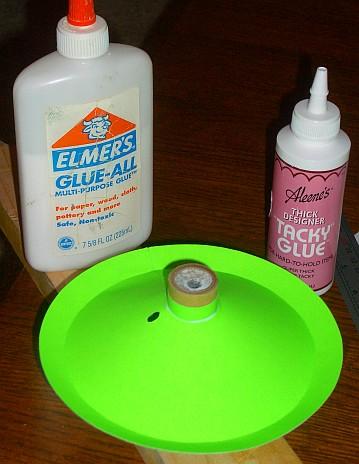
Elmer's Glue-All was used for most construction. For the fillets, I used Aleene's Thick Designer Tacky Glue. It goes on thick, stays in place, dries clear, and has minimal shrinkage. Yellow (wood) glue is specifically NOT recommended because it shrinks too much when it dries.
The first few steps consist of cutting out the motor mount, wrapping it around a used engine, and gluing the overlapping tab. A narrow band of cardstock is wrapped around the outside of the motor mount to form a thrust ring that will press against the upper body of the saucer. An optional motor block is then installed on the inside of the motor mount.
The upper body is formed by cutting out the upper body, then rolling it into a shallow funnel shape and gluing the overlapping tabs.
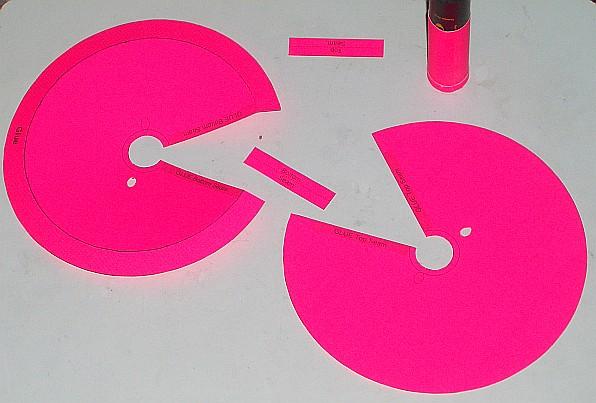
The lower body is a tiny bit more involved. Before gluing the tabs together, a seam must be scored around the outside edge and bent backwards to create a mating surface to join the two body halves. Hard to describe, but easy to do. This little trick is what allows the elimination of the foam-board disk that was used in the original Delta Flying Saucer.
After the body halves are dry, the motor mount is glued to upper body, then filleted.
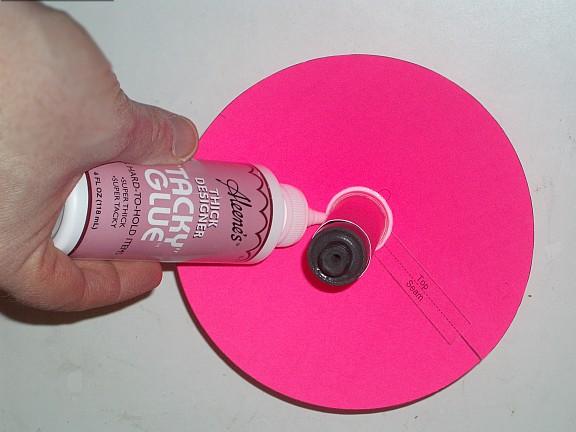
The lower body is then glued to the upper body along the mating surface on the rim.

I ran into a minor hiccup on this step when the glue grabbed on one edge before I had the other edge completely aligned. It was only off by less than 1/8 inch, so I just trimmed off the edge and it's no longer noticeable. On later builds I was more careful with the initial alignment and did not have this problem.
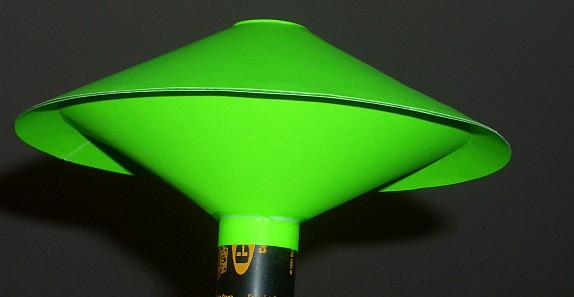
After applying a fillet where the motor mount touches the lower body, the build is done.
Finishing:
The only finishing that is recommended is a layer of clear-coat spray to
protect the cardstock from moisture. I used Rustoleum Gloss Clear on the pink
24mm model, and Rustoleum Painters Choice Gloss Clear on the other two. The
pink one turned out much shinier.
No decals are provided, but I don't think they are necessary.
Construction Rating: 5 out of 5
FLIGHT/RECOVERY
Recommended Motors
| 18mm Version | 24mm Version |
|---|---|
| Quest A6-4 Estes A8-3 Estes B4-2 Estes B4-4 Estes B6-0 Estes B6-2 Estes B6-4 Estes C6-0 Estes C6-3 Estes C6-5 Aerotech RMS 18/20 reloads |
Estes C11-0
Estes C11-3 Estes D11-P Estes D12-0 Estes D12-3 Estes E9-P Estes E9-4 Estes E9-6 Aerotech F21W Aerotech RMS 24/40 Reloads |
As this table shows, just about any engine will work in an Ultra Delta. The only ones that should be avoided are long-delay upper stage motors because the saucer will be back on the ground when the ejection charge fires.
Test Flights
Flight preparation consists of friction-fitting an engine and installing the igniter. I don't usually trust friction-fits, but since the front end is open there is no pressure buildup to blow the engine out the rear.
On the 24mm long version, a tape thrust ring must be installed around the bottom of the motor.
Having such similar rocket just begs for a drag race. The first race was between an 18mm C6-3 and a 24mm C11-3. The person pushing the button on the C11 was a bit slower so the C6 got a good head-start. With its higher thrust, the C11 caught up quickly and they both reached apogee at about the same time and altititude. They both tipped over and descended slowly for soft landings about 35 feet from the pad.
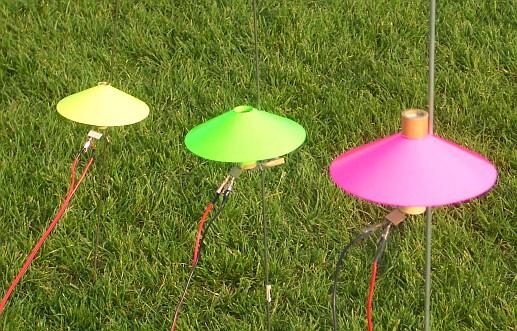
For the second race we loaded up the largest Estes engine that would fit in each size: C6-3, D12-3, and E9-4. I had recently rewired my launcher to handle clusters, so I was able to connect all three saucers to a single launch button.
After an initial delay, all three lit nearly simultaneously. The 18 mm on the C6-3 was fastest off the pad, but was quickly passed by the 24mm D12. With its long burn, the 24mm E9 kept going long after the others had burned out. The E9 saucer was corkscrewing during boost, which made an tight spiral smoke trail and an interesting sound. I have not reflown it to determine of this was a fluke or a feature.
The C6 and E9 both gently aero-shelled down, while the D12 fluttered to its
landing. All were recovered with no damage, within 25 feet of the pad.
A video of this flight is available here on Art Applewhite's web site.
Flight Rating: 5 out of 5
OVERALL:
Another great addition to the Applewhite saucer fleet. If you've never built a
saucer before, this would be a great kit to start with. Even if you have built
saucers before, this would still be a great kit to flywith the larger engines.
PROS:
- Simple yet sturdy design.
- Like all saucers, it flies well in small fields.
- Capable of using wide variety of motors.
CONS:
- None
Overall Rating: 5 out of 5
Other Reviews
- Art Applewhite Rockets Ultra Delta Flying Saucer By Dick Stafford
This is a simplified version (if you can believe that) of Art's 24mm Delta Flying Saucer . The kit is all cardstock and can be built with either an 18mm or 24mm motor mount. The kit contains two sheets of cardstock, containing seven parts to be cut out. Materials required are scissors, hobby knife with new blade, Elmer's white glue, new or used engine casing, cellophane tape, and ballpoint ...
 |
 |
Flights
Sponsored Ads
 |
 |






![Calling Marshall Applewhite [Explicit] Calling Marshall Applewhite [Explicit]](https://m.media-amazon.com/images/I/51MeUaBWTkL._SL500_.jpg)




